The people of Guanxi Province, in Southern China, have an expression: “I would rather live in Guilin”, they say, “than in heaven”.
Even if you haven’t heard of Guilin until now, there’s a chance you already know a little bit about it. Close your eyes and try to imagine rural China. Are you picturing misty peaks towering above lazy rivers? Cormorants fishing in the twilight? Rice terraces glittering in the sunshine?
Well, you’re really thinking about Guilin.
I was lucky enough to be able to spend two weeks there recently, as part of a longer trip around China. I have always been enchanted by that landscape—mostly from watching nature documentaries as a kid—and for the longest time I’ve wanted to just sit down in those hills and imagine for one fleeting moment that I’m part of that life.
But I also hoped that my time there would reveal something of the local history, culture, and the reality of day-to-day life in this remarkable environment.
I’m not sure how fully I succeeded at that objective, but I did get a small taste of both the reality and the daydream. I’ll try to share some of these experiences with you here, in the hope that it will persuade you to make a trip to this remarkable part of the world.
Arrival
As our plane comes into land, I glance out of the window. In the distance, wreathed in shadow, are the towering karsts that define this region. This is my first glimpse of a landscape we’ve traveled halfway across the world to see and I can’t wait to get out and explore.
These unique limestone structures are created when acids in rainwater slowly dissolve the bedrock, forming tiny cracks and fissures that deepen and expand over time. Eventually, this process culminates in the formation of sheer, isolated and well-defined peaks that rise sharply above the plains below.
There are many places in South East Asia where karst landforms can be seen, but they are arguably at their most spectacular in the area around Guilin.
But before we could get to exploring, we first needed to find our hotel. Guilin doesn’t have a train line from the airport to the city, unfortunately, so instead we jumped in a taxi—an experience in itself. With just one hand on the wheel—the other left free to produce an endless supply of pumpkin seeds—our driver whisked us down the highway and through the city, deftly skirting pedestrians and other vehicles whilst having hurried conversations with his family on the phone.
If you’re a soft Westerner like me then this sort of thing can feel a little chaotic at times. In Guilin, people use megaphones and huge PA systems to try and tempt you into buying fruit. The marketplaces and restaurants are always packed to the rafters and booming with noise. The traffic doesn’t stop, even at crossings, so you just have to dive out into a sea of mopeds and trust the riders to skim around you.
Don’t worry, it’s not their first rodeo.
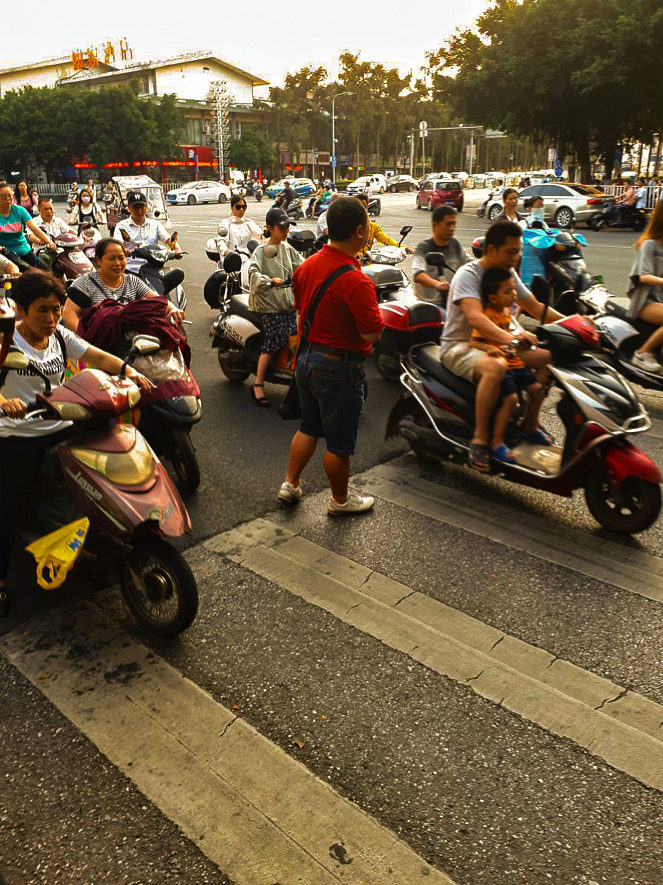
But the longer you spend in here, the more you realize that there’s actually a sense of order and security underpinning what at first looks like chaos. More than that, the people seem to embody a sense of calmness in the chaos that you really come to admire.
For example, near misses on the roads, which would certainly provoke profanity or even violence in my hometown, here draw barely a second look. Restaurant and shop owners will try and tempt you to dine, but if you say no then you’re offered a smile and left alone, not hectored as you try and walk away, as is the case in some parts of the world.
In the evening the streets come alive with young people, but that doesn’t stop the middle-aged and elderly bringing out their stereos, whacking on the dancing shoes, and joining in the fun in the town’s many underpasses, alleyways, and any other forgotten corners.
So, how much can you tell about a place in just two weeks, especially when you don’t speak the language? Not much, I’d say. Just an impression really. Sometimes those impressions are well-founded, sometimes not.
But our impressions of Guilin were of a place that feels welcoming; a place where the locals genuinely seem happy. Every smile, every kind gesture, every stranger who offered us help—and there were many—they all just kept adding to the strength of this impression.
If Guilin is heaven, you’d expect this to show through in the people who live there. You’d expect those people, for the most part, to be happy, relaxed, tolerant and inclusive.
Well, they really were.
The City
Guilin is a low rise, medium-sized city with a compact, walkable center. At the heart of the town is Zhengyang Pedestrian Street, a busy row of shops, bars and restaurants which is also a great place to sample the excellent local delicacy of beer-cooked catfish.
Walk a little further down this street and you arrive at Guilin Central Square, a popular meeting place and venue for public festivals. A little further still and you’ll find yourself looking out over Shanhu Lake. This is where we ended up on our first night in Guilin, transfixed by the astounding Sun and Moon Pagoda and talking to a local English teacher and part-time tea farmer who had adopted the name “Barry”.
From Barry we learn that the two pagodas, despite being been modeled on two much older structures that stood in the same spot, back in the Tang Dynasty, are relatively recent additions to Guilin. These two modern towers, we learn, are connected by an underwater tunnel with a glass roof. It’s also possible to get views over the city from the tops of either.
Don’t bother with that nonsense, says Barry, just look at them.
And they are a sight to behold, especially lit up at night, their reflections dancing over the water. The Sun Tower seemed to me to express confidence and energy, the Moon Tower, serenity and grace. Maybe I was feeling the effect of a few beers but they seemed like fitting monuments to the chaos and the calm that is life in Guilin.
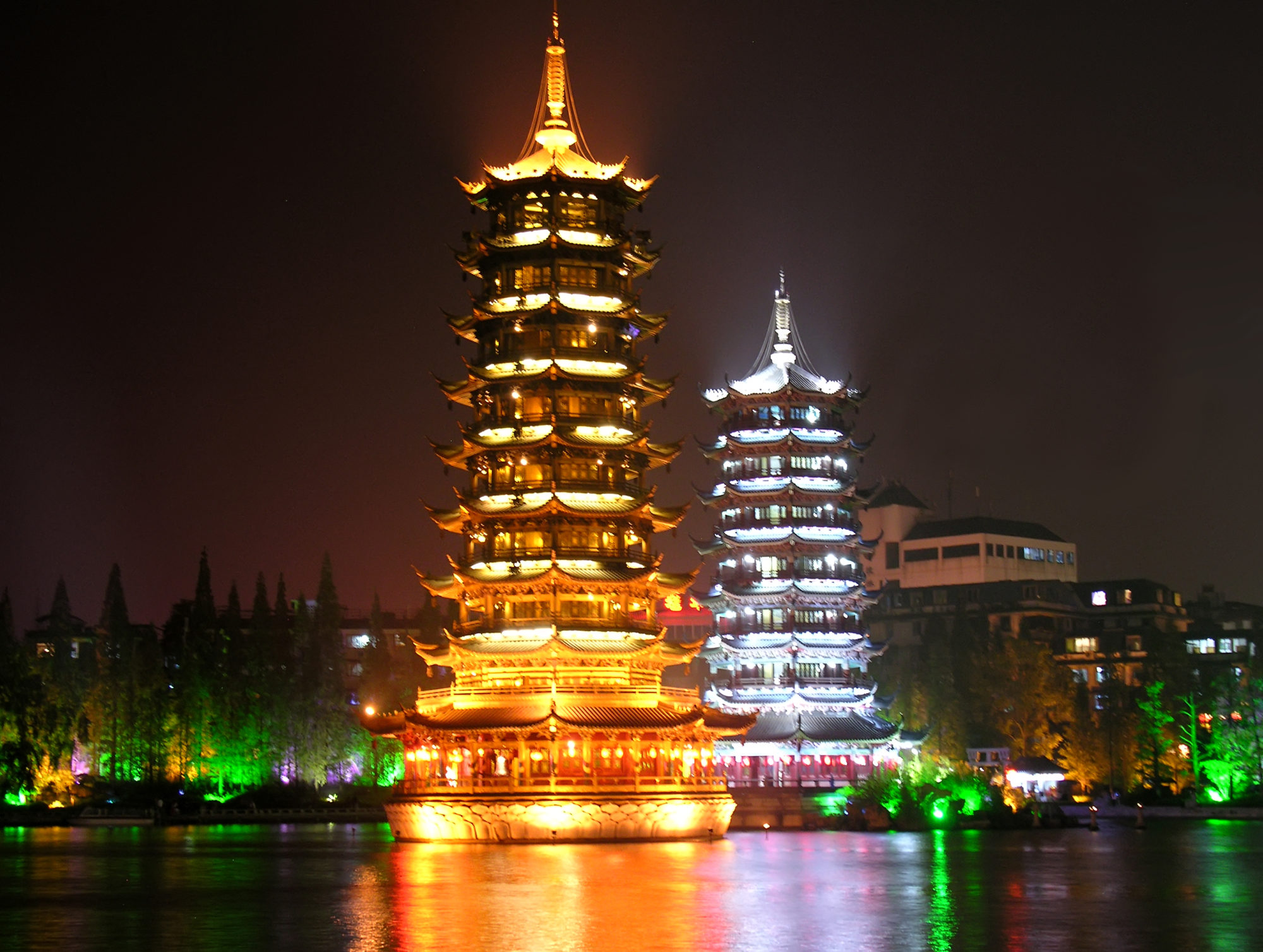

I’ll be honest, we were already pretty sold on Barry by this point, but then, without prompting or bribing, he announced that he loved football and had always wanted to go to my hometown of Manchester (UK). Instantly recognizing Barry as a man of impeccable taste and virtue, I began to envision a life on the tea plantations as his adopted son. But I didn’t let on. I decided I would play the long game.
Instead, we followed Barry’s suggestion to head back to the Central Square at 8.30pm to see “the waterfall”. Neither I nor my partner really understood his meaning at the time, but he’d long since earned our trust, so we went there, and we waited…
Just as we were beginning to doubt Barry’s integrity, all of a sudden music starts blaring from some hidden speakers, the small crowd that had gathered begins to buzz with enthusiasm, and as if by magic, water starts cascading 50 feet down from the roof of a nearby hotel, streaming over the windows and gathering in fountains on the street.
Oh, Barry! We never doubted you for a minute.
The next day we explore the area across the road from Shanhu Lake and find “Elephant Trunk Hill”, another icon of the city. According to legend, this strange rock formation was created when a Divine Elephant—the steed of the Emperor of Heaven—was wounded in battle and fell to Earth in Guilin. After being nursed back to health by a kindly local couple, the Elephant was said to have fallen in love with Guilin and so opted never to return to its master.
“I would rather live in Guilin”, it said, “than in Heaven”.
And there it remains to this day.
After a short but sweaty walk to the top of the Elephant’s back, I finally got the view of the karsts I had been hoping for, and it was breath-taking. I’m lucky to have done a fair amount of traveling in my time and I can honestly say it was one of the most beautiful landscapes I’ve ever seen.
I was beginning to think the Elephant might have had a point after all.
The Caves
Reed Flute Cave is the biggest and most spectacular cave complex in Guilin, arguably in China. Over the years it’s stunning features have been used by the Chinese government to impress all the great and good of world politics, as well as Richard Nixon.
Stepping into those vaulted ceilings it’s easy to see why the place is held in such high esteem. The variety of formations taken by the rock set the mind reeling; the intricacies of the patterns carved by natural forces inspire genuine awe. The use of rainbow-colored light displays, in my mind at least, only add to the ethereal quality of the place.
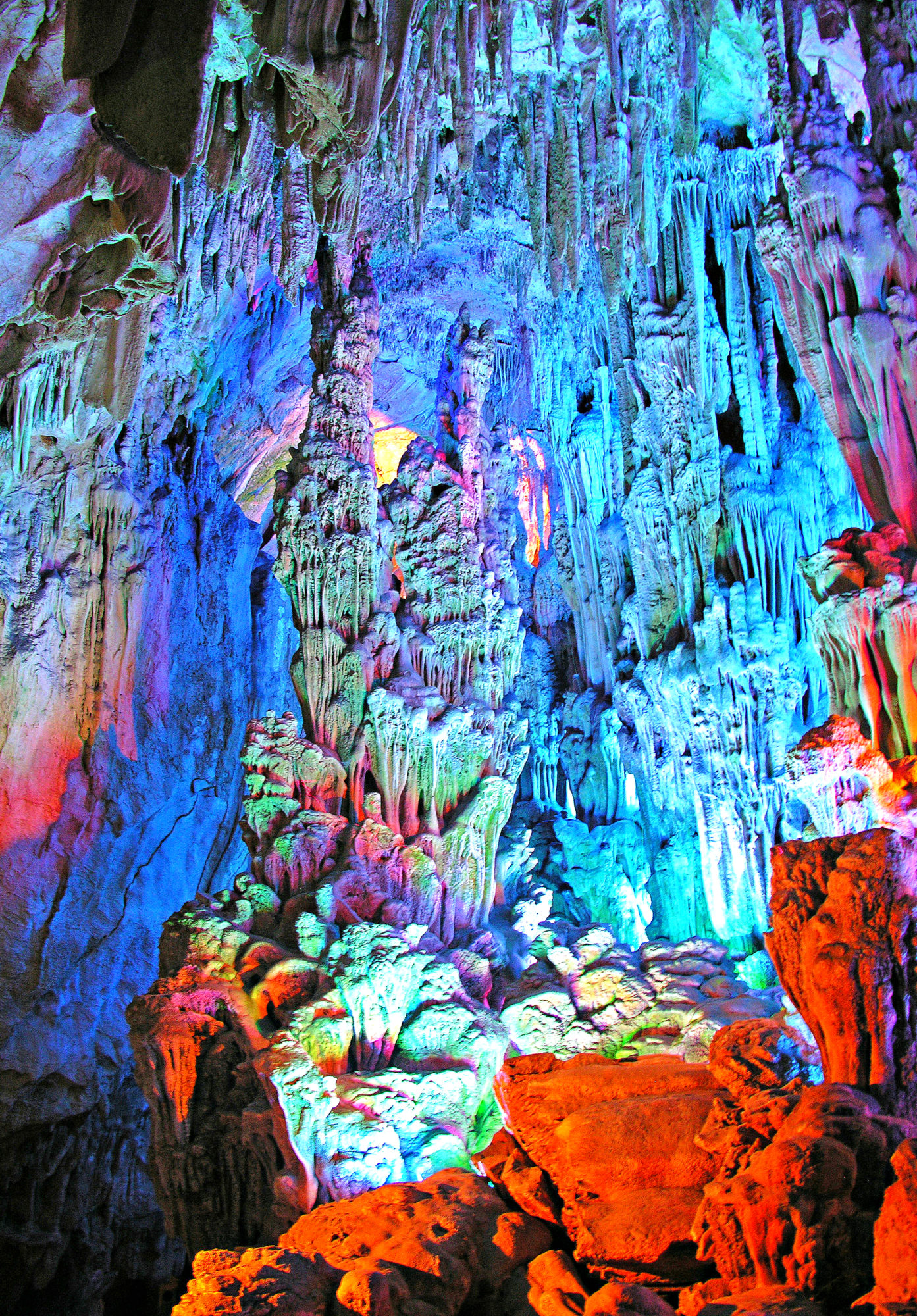

It was a similar story when we explored the cave at Seven Star Park. Although a little smaller, this cave is no less spectacular. In vast, cathedral-like spaces, stalagmites and stalactites join to form towering columns that rise like plumes of smoke all around us. Lights shimmer across the surface of natural pools; shadows dance on the walls. After several hours spent exploring subterranean wonderlands, it feels disconcerting when we eventually stumble back into the daylight.
On our way out of Seven Star Park we skip past the zoo and the tree-top adventure playground—one more reluctantly than the other—but there’s one last surprise awaiting us before we leave. Crossing the spectacularly misnamed “Flower Bridge”, we notice a crowd has gathered to gawp and point down to the river below.
Two bamboo boats, we discover, have collided and broken up in the water; the deck of one boat is all that remains intact, anchored on the rocks midstream. One bloke stands on top of the deck, another clings desperately to the side. The head of one less fortunate figure can be seen bobbing swiftly downstream, eventually making it to the bank a couple of anxious minutes later.
The police are called, survey the scene, call out to the men, have a brief conversation, then leave. Despite the fact that two men remain stranded in the middle of a river, apparently, it was decided, all was well. Calmness in the chaos.
The Rice Terraces
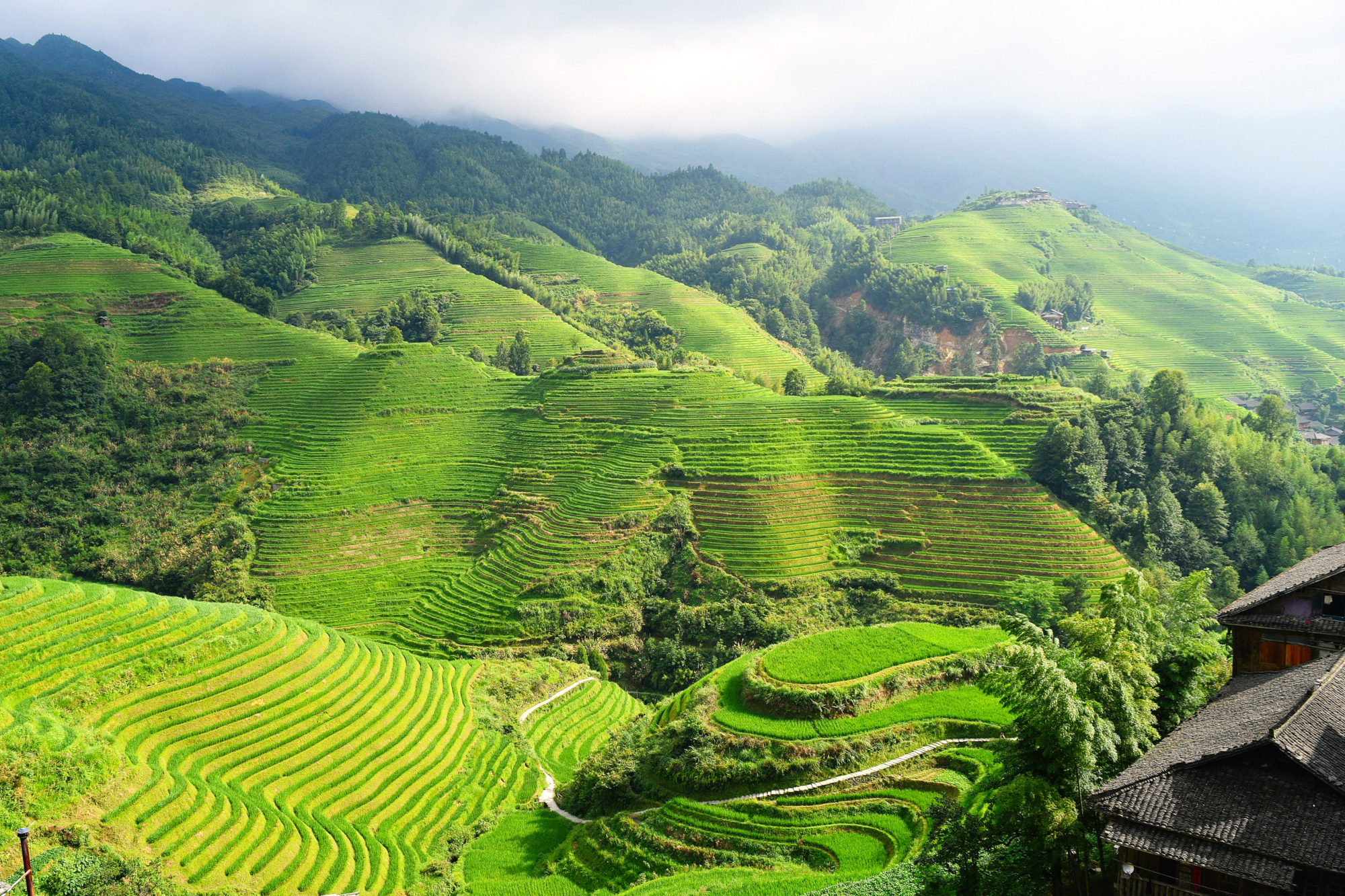

A bumpy three-hour bus ride takes us to our next destination, the Longji Rice Terraces. Despite my insistence we should hike from the vehicle drop-off point to the top of the hills, we decided instead to take the cable car. About halfway up I remember that I’m pretty unfit, and am thankful to have wiser heads around to remind me of this reality.
It’s a cloudy day, but on the occasions when the sun does break through, the hills seem to sing. The panoramic views of glistening water and lush hillsides are only broken by lone figures toiling in the fields.
It’s undeniably stunning, but a question plays on my mind of how authentic an experience this really is, and whether that even matters? Unlike cormorant fishing, which is a dying trade nowadays kept alive almost exclusively through tourist dollars, these are still working farms. The people who work here actually are farmers and not just playing dress-up for tourists.
There are crowds, but if you can look past that, then it’s certainly possible to feel some connection with an ancient, agrarian way of life that has endured for centuries, in the process forming the basis for much modern Chinese culture and cuisine.
And yet…a feeling is all it is really, and a fleeting one at that. Am I really any closer to knowing what it’s like to work in those fields, day-in-day-out, year after year? Do I have any genuine understanding of the communities that are forged in that beautiful but harsh environment? I have taken a closer look at the iconography of rural China, but am I any closer to really experiencing the substance of that life?
Not really.
But we must take what we can get. I was glad to be there, in the rural calm that underpins our urban chaos. We jump in our van and are transported back to the modern world, the deep connection to the past we sometimes glimpse, now already beginning to fade in the memory.
Still, it was a privilege to be there, if only for a short time.
Lunch
Lunch, I’m sorry to say, was less of a privilege. A whole chicken, minus the head but with very conspicuous feet, stuffed into a bamboo tube without seasoning or sauce, then flumped onto a plate was not what I’d been longing for if I’m brutally honest.
Still, when in Heaven…


On the positive side, the local style of cooking and serving rice inside a bamboo shoot was pretty great.
“God never hurls a chicken at you”, they say, “without opening a bamboo shoot”.
Yangshuo
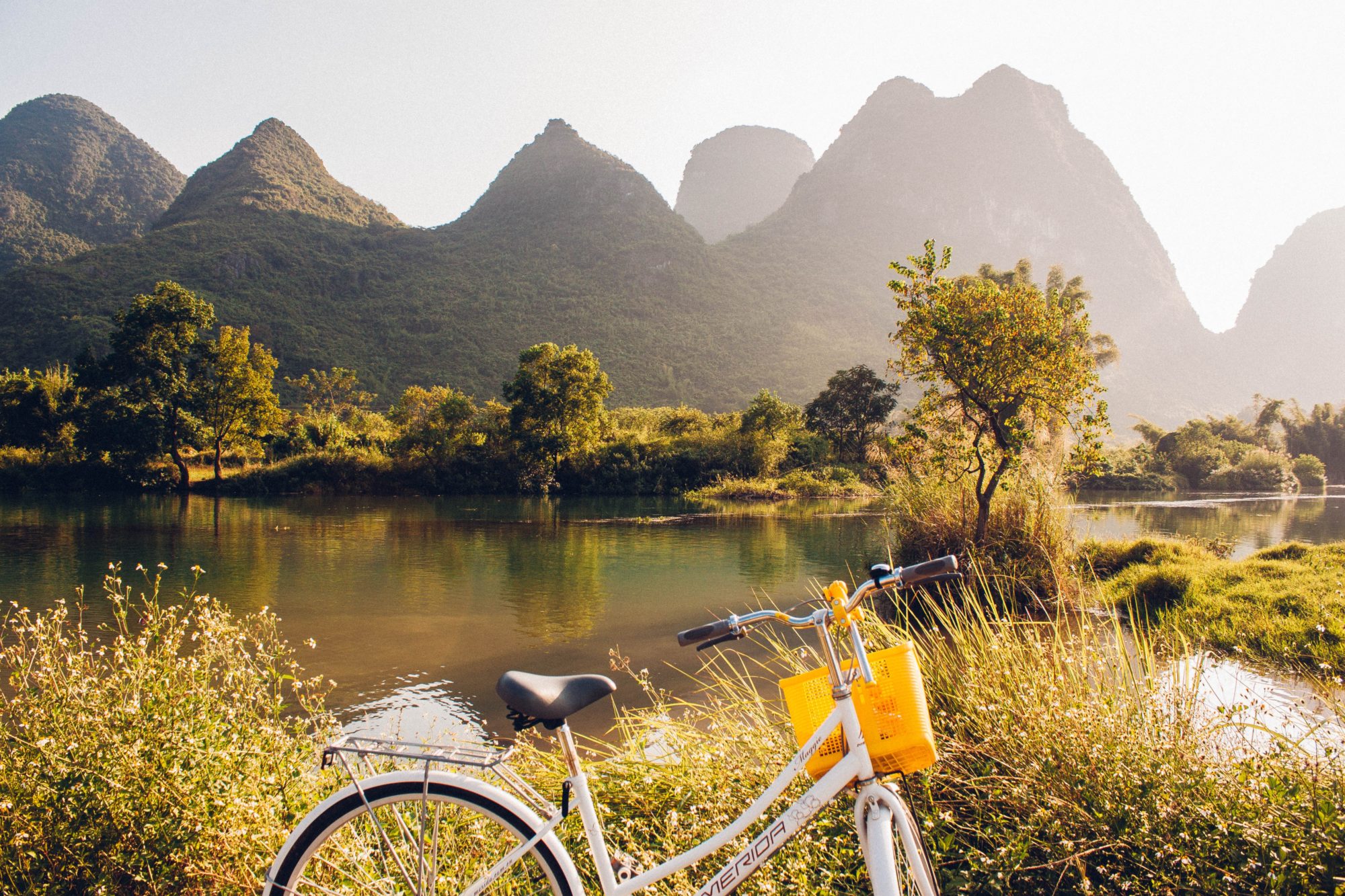

The highlight of any trip to the Guilin area is a trip down the gorgeous Li River valley towards the small town of Yangshuo. There are a variety of crafts of different sizes that sail up and down the river, but most people opt for the little 4-seater bamboo rafts. As our boat purrs gently down the river there’s plenty of time to sit back and take in the views. We’d thought the scenery in Guilin was amazing but things really amp up a notch as you get closer to Yangshuo.
(By the way, if you decide to take this journey then try to bring a 20 Yuan note with you if you can. It will become clear why when you’re en route).
Once we’d made it from Yangshuo to our hotel we were able to relax before heading to Yangshuo Cooking School. A small barn surrounded by forest and mountains became our home for the next couple of hours, and possibly the only place on Earth I’ve not been bored by cooking.


Here we learned how to make a variety of simple but tasty dishes, and I found many reasons to be thankful. I was thankful we had another chance to try the gorgeous beer-cooked catfish. I was thankful for our instructor’s patience after I took about 5 days to disassemble an aubergine with a meat cleaver. Most of all I was thankful to make it out with all my fingers still attached.
Becoming A World Famous Moped Rider
After several days near Yangshuo town center, we changed hotel to move deeper into the scenic area. Here we rented mopeds and set off to explore the area. OK, we attempted to rent mopeds, but after 15 minutes of watching me veer recklessly around the car park, the hotel staff politely but firmly regained the moped and handed us a bicycle.
I felt like someone who’s just been booted off American Idol after being told they can’t sing: secretly I knew they were right, but still I rode off with my head held high, vowing to become a world-famous moped rider one day and prove them all wrong.
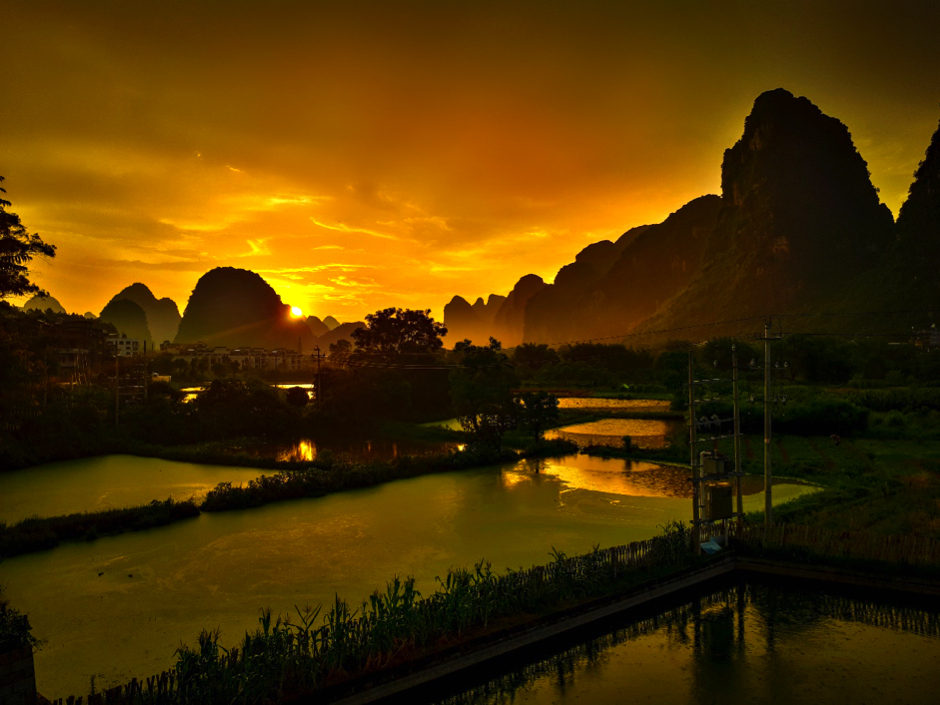

After some frankly incandescent bike riding we finished our stay in Yangshuo with a climb up Moon Hill. The hillside was steep, it was close to 35 degrees and a thunderstorm raged above us, but we would not be beaten. Step after step we fought on, every muscle in our bodies screaming at us to turn back, but we would not be beaten. Sweat streamed down our bodies, like tears in the rain, and we were being eaten alive by insects, but the summit was in sight.
We. Would. Not. Be. Beaten.
Laughing and panting (mostly panting), we arrived at the summit and were treated to another jaw-dropping view…
…And three very elderly women selling Cola.
They make that trek several times a day, often carrying heavy backpacks, deep into their old age. That sort of thing would take some of the buzz out of summiting Everest I’d imagine.


Back To Guilin
…And a chance to reflect. Are the locals right? Is the elephant right? Is Guilin really better than heaven?
Well, obviously no—it isn’t.
For one thing, I can’t conceive of a heaven that includes so many mosquitoes. Nor was I a fan of scraping the t-shirt from my back with a spatula each night (it’s hot). I’m also not so naïve as to think that once you probe beneath the surface you won’t find the same conflicts, struggles and social divisions that exist in every other city on Earth.
What Guilin really represents, to me, is more a sort of oasis. Despite the encroachments of urbanization and globalization, it remains a region whose natural beauty and cultural life have been preserved: a comparative haven of calm in the chaos that is modern China.
That’s not a criticism of China. Every country is changing fast. Every country needs places like this where we can connect with the past and commune with nature, even if the real action is happening elsewhere. Every country needs cities where we can transcend the madness and try to grasp at something eternal.
Guilin is that. It might not be heaven, but it does a pretty good impression.
Everything You Need To Know
How to get there:
Although Guilin is a comparatively small city, it was also the first Chinese city to open to tourism (in 1949), so access is now pretty easy. Cheap flights are available from Beijing, Xi’an and Shanghai, as well as a host of smaller cities across China. There are also international flights available from Osaka, Hanoi, Bangkok, Seoul, Singapore and Kuala Lumpur.
A full list of airports connecting to Guilin can be found here.
Train travel, unfortunately, is a little more complex. The best options are to come from Chengdu, Xi’an, or the Guangzhou/Shenzen/Hong Kong urban area in the South. If you decide to come by train then we highly recommend booking tickets through Travel China. We used them to book other rail tickets and they really made the process much smoother than we were expecting.
How to get around:
Guilin is easy enough to walk around providing you base yourself at a hotel that is reasonably central. There is no metro or tram system and the buses are confusing, so public transport is somewhat limited.
However, taxis are abundant and very cheap. Just be sure to have a copy of your hotel address in Mandarin to show to the driver, and download “Didi”—the Chinese equivalent of Uber—if you’re going away from the city center and are worried about getting stranded.
Where to stay:
If you’re looking for super cheap and cheerful accommodation then you could follow our lead and stay at the Cyan Box Hostel near Seven Star Park (roughly a 20-minute walk from town). We paid around 10 USD per night for a private double room, though dorms are available for around 5 USD. The accommodation is pretty basic, but the hostel has a nice vibe, it’s very safe and the staff were great. They can also help book tours to all the places mentioned in the article above.
Accommodation is still very cheap in China so if you’re looking for somewhere to stay that’s a little more upmarket then we’d recommend the Lijiang Waterfall hotel if you want to be very central, or the Sheraton Guilin, which is again fairly central, but just a little quieter.
In Yangshuo we stayed at the Bamboo Leaf Resort just outside town. The amenities and service were probably the best value of anywhere we experienced on our entire trip around Asia and I would recommend it whole-heartedly. Although the location is perhaps not ideal as it’s too far to walk comfortably in town. You’ll probably need to take a taxi to the hotel and then rent bikes/mopeds from their reception if you want to explore the town fully.
We then moved to the Zen Garden Resort in the scenic area. This was quite isolated, very quiet and just a bit strange, in that way that empty country hotels sometimes are. There were lots of frogs but very few people. I sort of felt like I was in a very polished version of The Shining. We spent a little extra on this hotel to get a nice view from our window and it certainly delivered on that, the location is great too. Other than that, though, I wouldn’t say it represents great value for money.
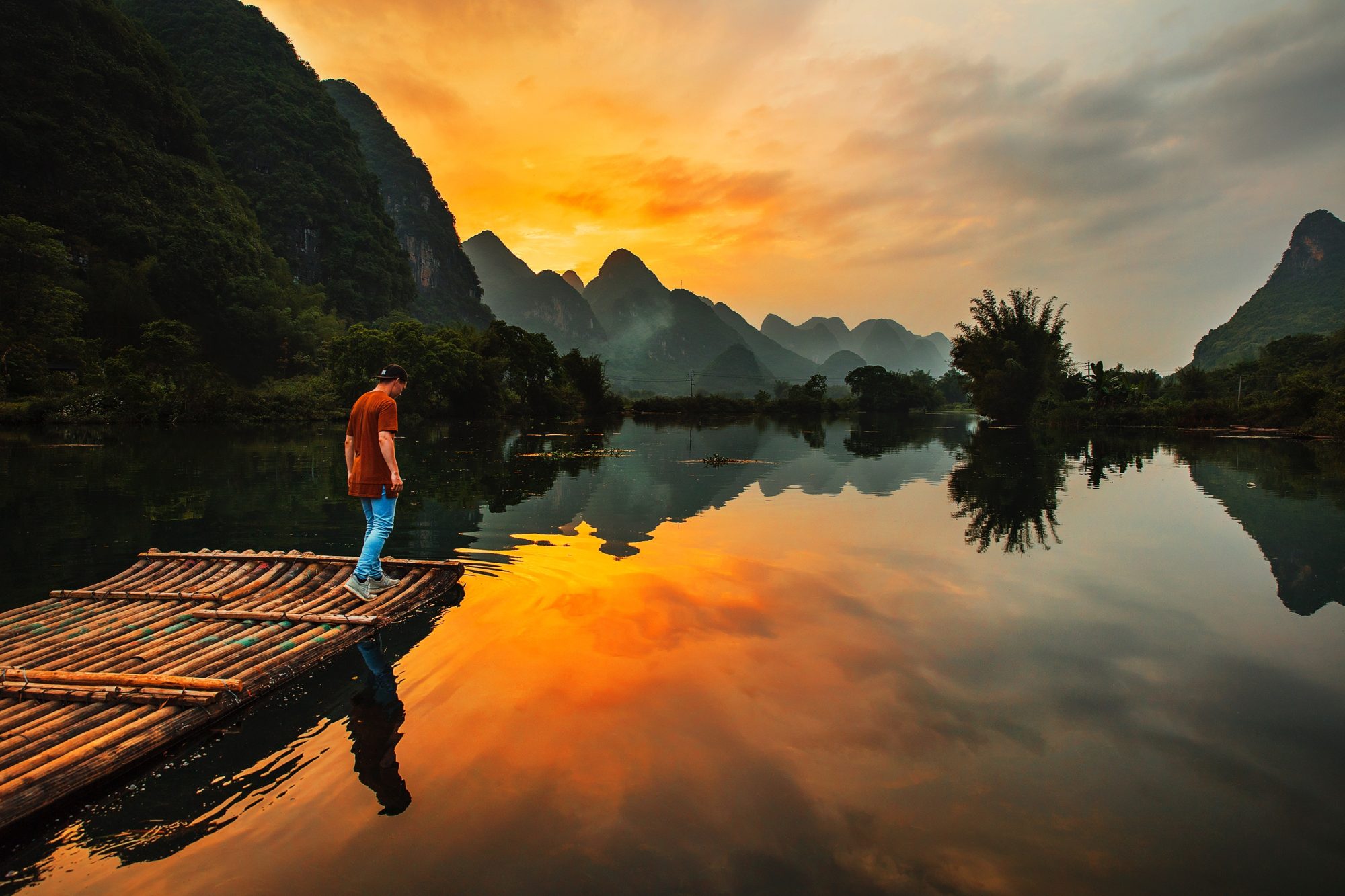

What became of Barry?
We don’t know. He told us where his tea shop was but to our shame we forgot what he’d said and we couldn’t find him again. If you see him, please tell him that we’re sorry and we love him.
Suggested next reading: 9 Gorgeous Locations In China That Will Take Your Breath Away (Part 1)




